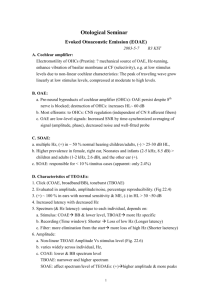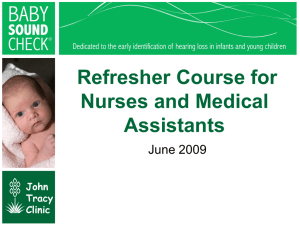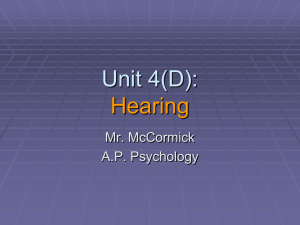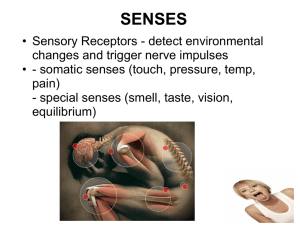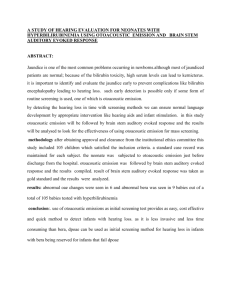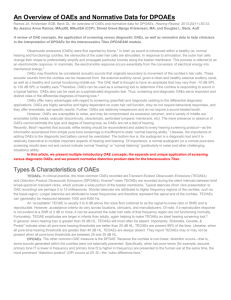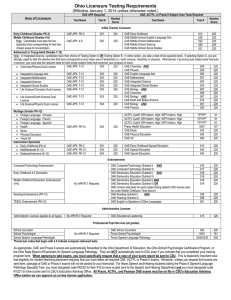Otoacoustic Emissions
advertisement
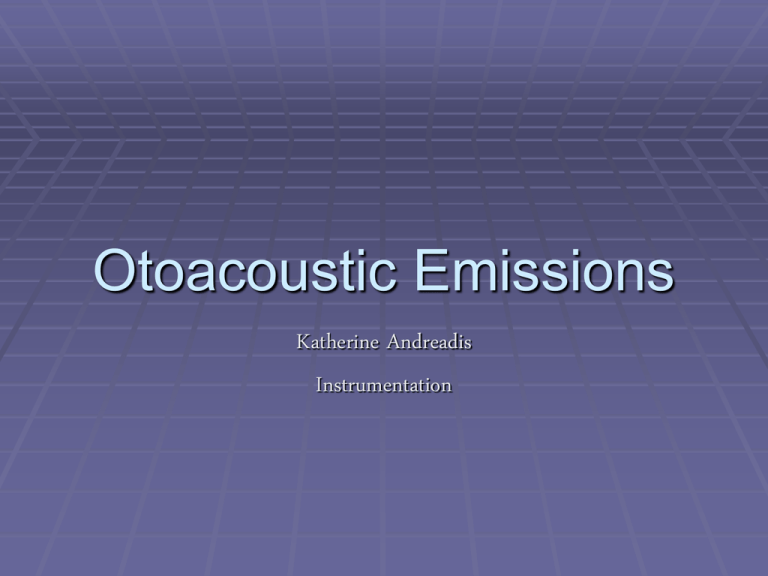
Otoacoustic Emissions Katherine Andreadis Instrumentation Background The presence of cochlear emissions was hypothesized in the 1940’s on the basis of mathematical models of cochlear nonlinearity. However, OAEs could not be measured until the late 1970s, when technology created the extremely sensitive low-noise microphones needed to record these responses. David Kemp first discovered Otoacoustic emissions in 1978. Otoacoustic Emissions Otoacoustic emissions are sounds that are produced by healthy ears in response to acoustic stimulation. OAE’s arise because our ears have evolved a special mechanism to give us extra hearing sensitivity and frequency responsiveness. The mechanism is known as the cochlear amplifier and it depends on a specialized type of cell called “outer hair cells.” It’s the job of the cochlea to receive the sound energy collected by the outer and middle ear and to prepare it for neural transmission. Purpose of OAE’s The primary purpose of otoacoustic emission (OAE) tests is to determine cochlear status, specifically hair cell function. This information can be used to (1) screen hearing (2) partially estimate hearing sensitivity within a limited range (3) differentiate between the sensory and neural components of sensorineural hearing loss (4) test for functional hearing loss. Types of OAE’s Types Spontaneous OAE’s (SPOAE’s) Distortion Product OAE’s (DPOAE’s) Transient Evoked OAE’s (TEOAE’s) Spontaneous OAE’s Occurs in the absence of any intentional stimulation of the ear. Prevalence is in about 40-60% of normal hearing people. When you record SOAE’s, you average the number of samples of sounds in the ear and perform a spectral analysis. SOAE’s are more common in the right ear and two times more common in females than males. The presence of SOAE’s is usually considered to be a sign of cochlear health, but the absence of SOAE’s is not necessarily a sign of abnormality. Distortion Product OAE’s Result from the interaction of two simultaneously presented pure tones. Stimuli consist of 2 pure tones at 2 frequencies (ie, f1, f2 [f2>f1]) and 2 intensity levels (ie, L1, L2). The relationship between L1-L2 and f1-f2 dictates the frequency response. DPOAEs allow for a greater frequency specificity and can be used to record at higher frequencies than TOAE’s. Therefore, DPOAE’s may be useful for early detection of cochlear damage as they are for ototoxicity and noise-induced damage. DPOAEs often can be recorded in individuals with mild-to-moderate hearing losses for whom TOAE’s are absent. *DPOAE’s do not occur in the frequency regions with up to 50-55dB Hearing loss. * DPOAE’s can be elicited from ears that have a greater hearing loss than TEOAE’s. Transient Evoked OAE TEOAE’s are frequency responses that follow a brief acoustic stimulus, such as a click or tone burst. The evoked response from this type of stimulus covers the frequency range up to around 4 kHz. In normal adult ears, the click-elicited TEOAE typically falls off for frequencies more than 2 kHz, and is rarely present over 4 kHz, because of both technical limitations in the ear-speaker at higher frequencies and the physical features of adult ear canals so that is why DPOAE’s would be more efficacious. For newborns and older infants, the TEOAE is much more robust by about 10 dB and typically can be measured out to about 6 kHz indicating that smaller ear canals influence the acoustic characteristics of standard click stimuli much differently than do adult ears. TEOAE’s do not occur in people with a hearing loss greater than 30dB. TEOAE & DPOAE Recording OAE’s OAEs are measured by presenting a series of very brief acoustic stimuli, clicks, to the ear through a probe that is inserted in the outer third of the ear canal. The probe contains a loudspeaker that generates clicks and a microphone that measures the resulting OAE’s that are produced in the cochlea and are then reflected back through the middle ear into the outer ear canal. The resulting sound that is picked up by the microphone is digitized and processed by specially designed hardware and software. The very low-level OAEs are separated by the software from both the background noise and from the contamination of the evoking clicks. Absent OAE’s due to…. Cyst Otosclerosis External Otitis Cholseteatoma Stenosis Cochlear Pathology Types of Machines for OAE Today otoacoustic emission recording is achieved by a variety of otoacoustic instruments. Hand-held and pocket-sized screeners are available which provide a quick indication of the status of the ear and are widely used for infant screening. Because OAE’s are blocked by middle ear immobility, these instruments alert to both conductive and sensory dysfunction. Some OAE screeners provide a single indicator of function across speech frequencies Clinical Use The creation of OAE’s by the cochlea and the reemission of this energy as sound from the ear serve no important physiological purpose that can be determined. Their clinical significance is that they are evidence of a vital sensory process arising in the cochlea. OAE’s only occur in a normal cochlea with normal hearing. If there is damage to the outer hair cells producing mild hearing loss, then OAE’s are not evoked. A good rule of thumb is that OAE’s are present if hearing is 35 dB or better. Because OAE’s are evoked by signals that have a wide frequency response, a broad region of the cochlea responds, providing information on the frequency range from 1000 Hz to 4000 Hz. Usefullness OAE's are most appropriate for use in difficult-to-test patients: newborn infants, young children, patients who are attempting to feign a hearing loss, and developmentally delayed populations. OAEs only provide information about the activity of the cochlea, and do not assess the status of the rest of the auditory pathway. TEOAE's are commonly used to screen infant hearing, to validate auditory thresholds obtained via other techniques, and to assess the cochlear contribution to hearing. DPOAE's are also used for infant screening. They can be obtained in persons in whom TOAE's cannot be obtained, and they can be obtained at higher frequencies than TOAE's (i.e. over 1000 hz).
